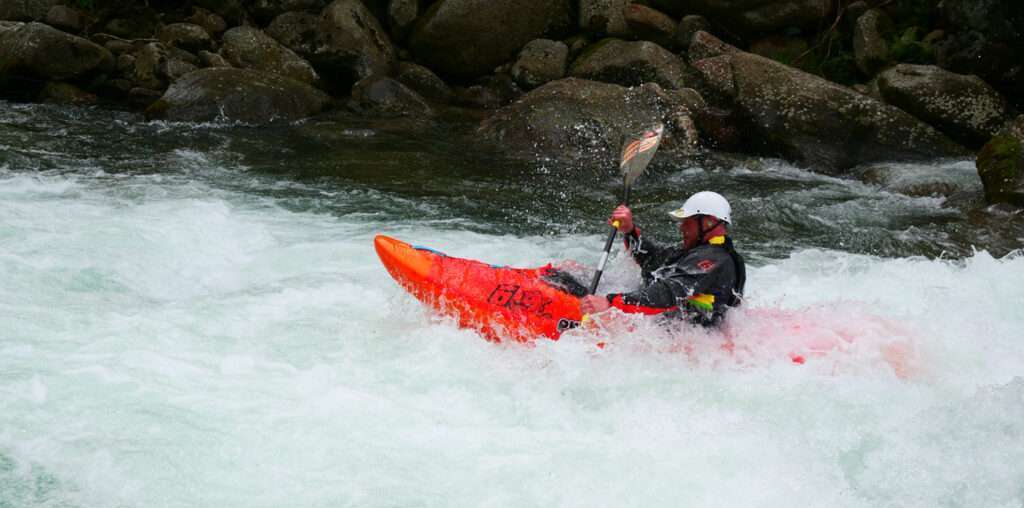What is Olympic canoe / kayak? Even though canoeing and kayaking are centuries old activities, they weren’t introduced to the Olympics until the 1924 Games. 12 years later, in 1936, flatwater canoe / kayak racing gained full Olympic event status. In 1972, the whitewater version of canoe / kayak known as Slalom was added to the Olympics.
Competition
In today’s Olympics, men and women compete in 16 different Flatwater and Slalom Olympic Canoe / Kayak events:
Canoe / Kayak Flatwater Races
- C-1 Men: 500m, 1000m
- C-2 Men: 500m, 1000m
- K-1 Men: 500m, 1000m
- K-2 Men: 500m, 1000m
- K-4 Men: 1000m
- K-1 Women: 500m
- K-2 Women: 500m
- K-4 Women: 500m
Canoe / Kayak Slalom Races
- C-1 Men
- C-2 Men
- K-1 Men
- K-1 Women
Canoe / Kayak Flatwater Races
Flatwater races are held on calm water across a 500m or 1000m course. The kayakers or canoeists paddle in lanes that are delineated with ropes and buoys. The “C” stands for Canoe. “K” stands for kayak. The numbers that follow the “C” or “K” represent the number of paddlers in a canoe or kayak.
Canoe / Kayak Slalom Races
Slalom races require the canoeists and kayakers to paddle a 300 meter course in the shortest time possible. There are 20 to 25 gates which hang above the river without coming into contact with the gates themselves. The gates are arranged in such a way that the paddler must go through them in the correct direction. Some must be entered from upstream and others are entered from downstream. Penalties are assessed on each paddler’s time based on gates they either touched or missed.
Equipment
Olympic Canoe / Kayak uses the following equipment:
Canoe: A boat that paddlers kneel in and paddle with a single-bladed paddle.
Kayak: A narrow boat that paddlers sit in and paddle with a double-bladed paddle.
Double-Bladed Paddle: A device containing two blades that is used to propel a kayak through the water.
Single-Bladed Paddle: A device containing one blade that is used to propel a canoe through the water.
Spray Skirt / Spray Deck / Splash Cover: Worn around the paddler’s waist and torso, the spray skirt attaches securely to the kayak or canoe and serves to keep water out of the boat.
Helmet: Meant to protect the paddler’s head. Helmet’s are padded on the inside and contain a hard shell on the outside.
Lifejacket: Also known as Personal Flotation Device or PFD. A PFD is secured to a person’s torso and ensures that the paddler will float in the event that he or she gets separated from the boat.
Gate: A pair of striped poles that hang from above the river. The paddler attempts to paddle through the gate without making contact with it.
Buoys: Separates the lanes for individual kayaks or canoes in the Canoe/Kayak Flatwater events.
CANOE/KAYAK: GOLD, SILVER, BRONZE
The Flatwater Racing Competition is won by the person who reaches the finish line of an unobstructed course in the shortest amount of time possible. Paddlers must stay in their lanes for the duration of the race. Gold, Silver, and Bronze medals are awarded in all Olympic Canoe / Kayak Flatwater Racing Events.
The Slalom Racing Competition is won by the competitor who scores the shortest time while navigating the turbulent 300 meter course. A 2 second penalty is assessed for touching each gate as it is gone through. A 50 second penalty is added to the paddler’s time for missing the gate altogether. Gold, Silver, and Bronze medals are awarded in all Olympic Canoe / Kayak Slalom Racing Events.

